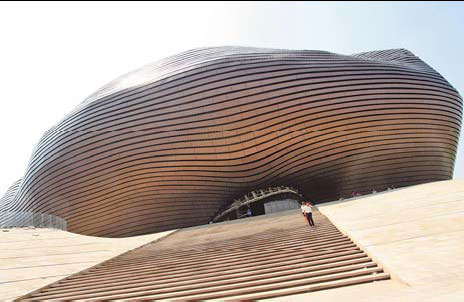Life and Leisure
Ordos rises from the grassland
By Jules Quartly (China Daily)
Updated: 2010-09-16 08:00
 |
Large Medium Small |
|
The landmark Ordos Museum in Kangbashi nears completion. |
Ordos has two faces, the old and the new. Dongsheng district is your average lower-tier city trying to keep up with the times, while Kangbashi is a brave new world of pretty yellow villas and apartment complexes sprouting from the plains. A 30-minute drive on a smooth highway links the two and makes them one.
While most planners are content to bulldoze the past as a foundation for the future, or play a game of mix-and-match when it comes to traditional and modern elements, the Inner Mongolia autonomous region city has tried something different, a third-way approach to metropolitan expansion.
The jury is still out on the Ordos experiment but it is a spirited response to a unique set of circumstances that aims to build what is essentially a satellite city of 300,000. It has already produced some outstanding public and private-use buildings and its potential is obvious to anyone who visits.
While Dongsheng dries up due to a lack of water and chokes in its own fumes caused by cars, building sites and factories, Kangbashi's canvas is a blue vault of sky that spreads over the prairie, while planners and architects realize their dreams of what the city of the future should look like.
They obviously have an epic vision, as even the streets have three lanes. Singaporean planning firm AGV, the occasionally controversial artist Ai Weiwei and the ORDOS100 group of international architects have been prime movers behind the new look, while the Beijing-based design company MAD is behind the landmark Ordos Museum, modeled on the image of the sun rising on the grassland.
This soon-to-be finished building faces Genghis Khan Square, a massive public plaza surrounded by city government buildings, a three-towered leaning library, a cultural center and a theater that looks like a pair of his-n-her Mongolian hats. In the middle of the square is a pair of prancing horses standing on their hind legs, neighing to the heavens.
But there aren't many restaurants for the simple reason there aren't any customers. Yes, the roads are clear, but so too are the pavements and ice-cool malls. Riding around in a car the new Ordos still looks more like a computer model than a real place.
A Bloomberg report claims 90 percent of the private buildings in Kangbashi have been bought, but only 5 percent are resided in. For this reason, it has been called a ghost town and the "Empty City". Government workers and businessmen who turn up on weekdays return in the evening and on weekends to Dongsheng, where their children go to school.
What's happening here is rich locals (and there are lots of them) who used to put their money into Beijing apartments now hand over cash to buy a designer villa in Kangbashi. Then they leave it in the expectation that it will appreciate.
The doubters say there is no way these buildings will grow in value and are cynical about the build-it-and-they-will-come approach. Their opinion is Kangbashi is a folly, but this ignores some realities on the ground.
To know Ordos, one first needs to understand the resources underpinning it, "China's 21st century energy bank" of coal, gas, oil and rare minerals. In addition, there are vast swathes of forests, prairie for sheep, cattle and grain.
I was convinced of Ordos' potential when I took a trip to nearby Baotou and saw a side road lined with power stations stretching for up to 50 km, with coal and gravel trucks nose-to-nose and rumbling along like an ancient caravan.
The city is affluent, second only to Shanghai, according to some estimates. GDP has grown 25 percent a year over the past eight years, twice the national average, and per-capita GDP is at least $21,600, double that of Beijing, according to a Bank of America-Merrill Lynch report.
The only poor people are the busloads of laborers from neighboring Shanxi province and elsewhere who arrive on short-term contracts to build the dream. Meanwhile, hotels, stores and companies are opening up and personnel from around the country are pouring in to take care of business.
Of all the places I have visited, Ordos reminds me most of Texas, but with more resources. It has only just begun to realize its immense potential and the people seem to have Texas-sized ambitions. Thinking big is reflected in the Mongolian-style boots worn by locals and the favored mode of transport, white Toyota Land Cruiser Prados or unmarked black Range Rovers, all in a hurry to get wherever they're going.
If you're willing to bet on futures, Ordos looks set to shine.
China Daily
